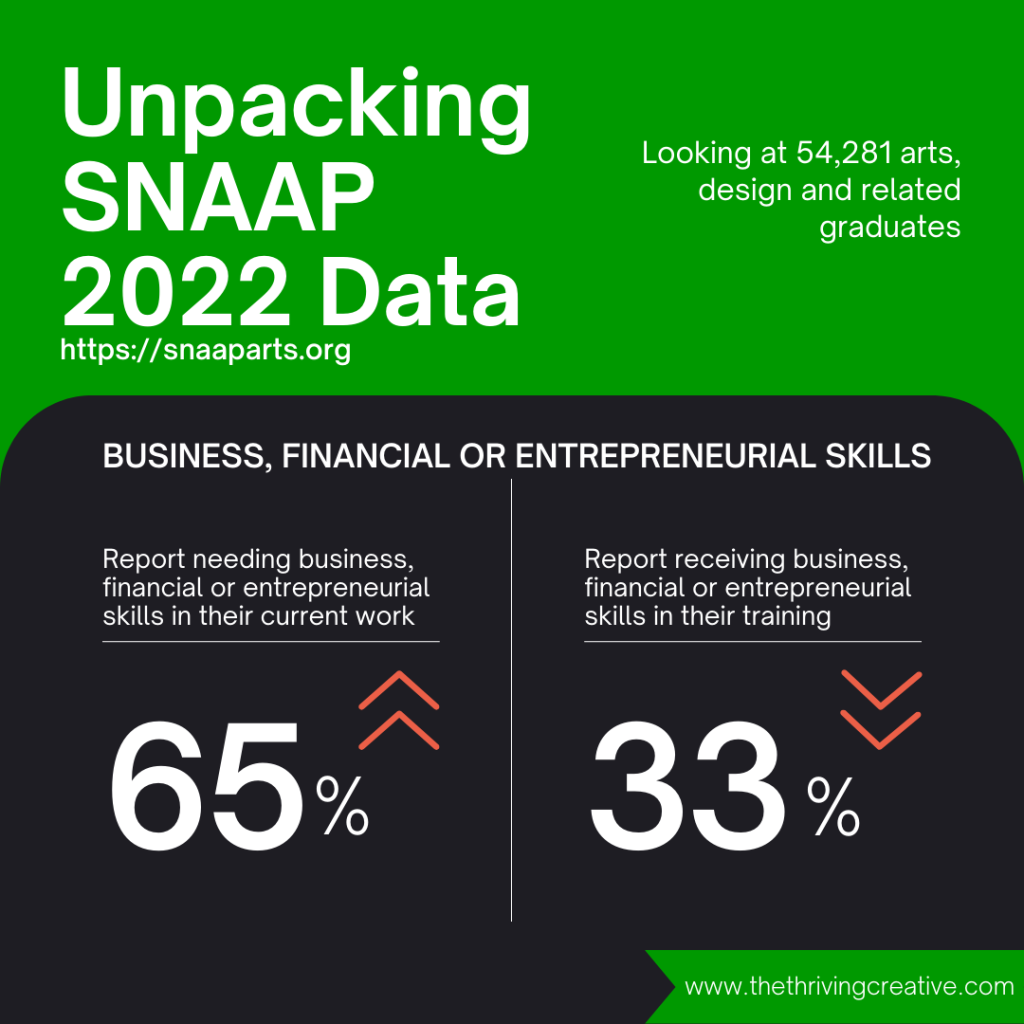
Last post I looked at some headline findings released in April 2024 of the SNAAP 2022 survey of 54K arts, design and related graduates from American universities[1]. Here are some other interesting findings that give a good portrait of the working lives of creative graduates:
For creative graduates work – 87% of the alumni between 18-64 report being in the workforce in September 2022, which is a higher employment rate than the general American workforce.
Retirement might not be a thing – only 37% of arts and design related alumni over 65 were retired, with 58% still in the workforce. There may be many reasons for this – on the positive side they may really enjoy their work and on the negative side they may not be able to afford to retire, or both. Further data is needed to understand this. It may be that a creative career is a longer career than many other more traditional occupations, and maybe that’s okay (I am in my 50s but find it hard to imagine stopping work at some point in my future, even if I could afford to do so).
Recent graduates are struggling – alumni who have graduated in the past two years report a significantly lower workforce participation rate than alumni who have been out for longer. This is very likely a COVID legacy and so more mentorship and support for recent graduates is needed.
Don’t fixate on your job title – while 56% of arts and design alumni self-identify that they are in an arts- or design-related occupation, 75% of arts and design alumni report they have arts- or design-related duties in their job, regardless of the job title. I remember this experience in my 20s when I took a job for a period in the forestry and agriculture library at my local university. I was expecting to die of boredom since I had no interest in forestry or agriculture, but my alert-to-potential manager kept me busy doing all kinds of creative projects creating signage, designing flyers, and teaching workshops. What could have been a dead-end job for a creative graduate used a number of my creative skills despite my non-creative work title. For young graduates, I think it’s vital to realise that creative work can be found (and made) in all kinds of not seemingly appearing creative environments. Any job is what you make of it, after all.
Multi-hyphenates are a thing – I always identified as a multi-hyphenate. In my day I worked as an actor-singer-dancer-writer-director-choreographer. All of those identities were important both for my creative expression but also my ability to generate a living in a creative field. Even today I would describe myself as a coach-trainer-teacher-leader-writer-researcher – so the multi-hyphenate state continues! The SNAAP 2022 data found that half of alumni who self-identified working in an arts or design field chose two or more art- and design-specific occupations to describe their work. When we’re working with young creatives, are we trying to force them into choosing just one field or are we giving them tools to embrace a multi-hyphenate identity? And how do we help people to lean into multi-hyphenate careers and thrive in them?
Multiple employers are also a thing – 54% of those self-employed who have arts or design duties report having multiple employers, compared to just 30% of self-employed working outside of arts or design fields (and only 12% of those in employment report having multiple employers). This speaks to a need for project management, time management and client management skills to juggle multiple employers. This may be related to the multi-hyphenate idea above where different facets of their skill set are being used with different contractors. This is a portfolio career and can be very desirable for a creative, but also requires a lot of skill to market and manage effectively.
Self-employment is not necessarily a 9-5 job – 16% of the freelancers with art/design duties as a regular part of their work report working 51 or more hours per week (compared to 12% of those in art/design employment and 9% of both self-employed and employed working outside of art/design). At the same time, both creative and non-creative freelancers report a much higher percentage of workers who work 35 hours or less per week (43% of freelancers with art/design duties and 45% of freelancers in non-art/design work). This does raise questions of whether this reflects the agency of choice, ie. they earn sufficiently working fewer than 35 hours per week in their self-employed work that this is all they do, or does this reflect scarcity that they don’t have enough self-employed work to fill their week? Again, interesting questions. How do we prepare students or coach creatives for either possibility?
Happiness – I think it’s really interesting that SNAAP tries to quantify the satisfaction of arts/design alumni and there is a lot of nuance to the data – so I’m not going to try to summarise it here. Have a read of the full report. It’s generally quite optimistic that arts/design alumni seem relatively satisfied with the pathway they have chosen. But read for yourself and draw your own conclusions.
For now, my focus is on the freelancers and self-employed and this data is useful as I work on my book on creative freelancers and I think raises valuable questions worth reflecting on for educators and coaches who work with creatives.
What is your take-away from this latest SNAAP report? Please comment below.
Feel free to reach out to me to discuss any training or coaching needs you or your organization might have around working in the creative sector.
[1] Novak-Leonard, J. L. (2024). Arts & Design Alumni Perspectives on Employment & Career Outcomes, Strategic National Arts Alumni Project Report. Austin, TX: Arts + Design Alumni Research, SNAAP.
Leave a Reply